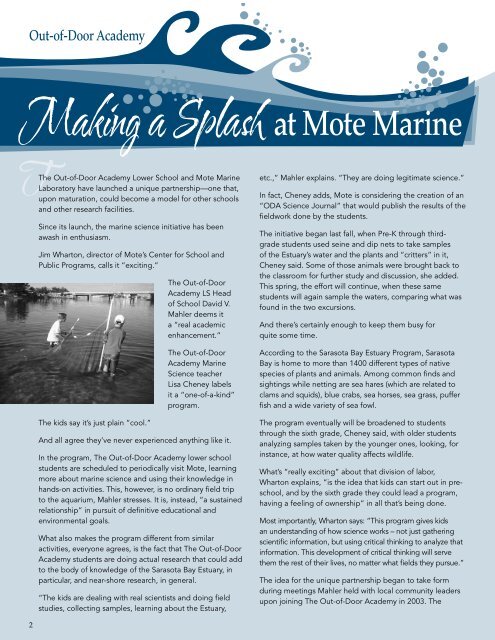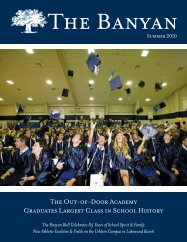You also want an ePaper? Increase the reach of your titles
YUMPU automatically turns print PDFs into web optimized ePapers that Google loves.
<strong>Out</strong>-<strong>of</strong>-<strong>Door</strong> <strong>Academy</strong><br />
Making a Splash at Mote Marine<br />
<strong>The</strong> out-<strong>of</strong>-door <strong>Academy</strong> lower school and mote marine<br />
laboratory have launched a unique partnership—one that,<br />
upon maturation, could become a model for other schools<br />
and other research facilities.<br />
since its launch, the marine science initiative has been<br />
awash in enthusiasm.<br />
Jim Wharton, director <strong>of</strong> mote’s center for school and<br />
Public Programs, calls it “exciting.”<br />
<strong>The</strong> kids say it’s just plain “cool.”<br />
<strong>The</strong> out-<strong>of</strong>-door<br />
<strong>Academy</strong> ls head<br />
<strong>of</strong> school david V.<br />
mahler deems it<br />
a “real academic<br />
enhancement.”<br />
<strong>The</strong> out-<strong>of</strong>-door<br />
<strong>Academy</strong> marine<br />
science teacher<br />
lisa cheney labels<br />
it a “one-<strong>of</strong>-a-kind”<br />
program.<br />
And all agree they’ve never experienced anything like it.<br />
in the program, <strong>The</strong> out-<strong>of</strong>-door <strong>Academy</strong> lower school<br />
students are scheduled to periodically visit mote, learning<br />
more about marine science and using their knowledge in<br />
hands-on activities. This, however, is no ordinary field trip<br />
to the aquarium, mahler stresses. it is, instead, “a sustained<br />
relationship” in pursuit <strong>of</strong> definitive educational and<br />
environmental goals.<br />
What also makes the program different from similar<br />
activities, everyone agrees, is the fact that <strong>The</strong> out-<strong>of</strong>-door<br />
<strong>Academy</strong> students are doing actual research that could add<br />
to the body <strong>of</strong> knowledge <strong>of</strong> the sarasota Bay estuary, in<br />
particular, and near-shore research, in general.<br />
“<strong>The</strong> kids are dealing with real scientists and doing field<br />
studies, collecting samples, learning about the estuary,<br />
etc.,” mahler explains. “<strong>The</strong>y are doing legitimate science.”<br />
in fact, cheney adds, mote is considering the creation <strong>of</strong> an<br />
“odA science Journal” that would publish the results <strong>of</strong> the<br />
fieldwork done by the students.<br />
<strong>The</strong> initiative began last fall, when Pre-K through thirdgrade<br />
students used seine and dip nets to take samples<br />
<strong>of</strong> the estuary’s water and the plants and “critters” in it,<br />
cheney said. some <strong>of</strong> those animals were brought back to<br />
the classroom for further study and discussion, she added.<br />
This spring, the effort will continue, when these same<br />
students will again sample the waters, comparing what was<br />
found in the two excursions.<br />
And there’s certainly enough to keep them busy for<br />
quite some time.<br />
According to the sarasota Bay estuary Program, sarasota<br />
Bay is home to more than 1400 different types <strong>of</strong> native<br />
species <strong>of</strong> plants and animals. Among common finds and<br />
sightings while netting are sea hares (which are related to<br />
clams and squids), blue crabs, sea horses, sea grass, puffer<br />
fish and a wide variety <strong>of</strong> sea fowl.<br />
<strong>The</strong> program eventually will be broadened to students<br />
through the sixth grade, cheney said, with older students<br />
analyzing samples taken by the younger ones, looking, for<br />
instance, at how water quality affects wildlife.<br />
What’s “really exciting” about that division <strong>of</strong> labor,<br />
Wharton explains, “is the idea that kids can start out in preschool,<br />
and by the sixth grade they could lead a program,<br />
having a feeling <strong>of</strong> ownership” in all that’s being done.<br />
most importantly, Wharton says: “This program gives kids<br />
an understanding <strong>of</strong> how science works – not just gathering<br />
scientific information, but using critical thinking to analyze that<br />
information. This development <strong>of</strong> critical thinking will serve<br />
them the rest <strong>of</strong> their lives, no matter what fields they pursue.”<br />
<strong>The</strong> idea for the unique partnership began to take form<br />
during meetings mahler held with local community leaders<br />
upon joining <strong>The</strong> out-<strong>of</strong>-door <strong>Academy</strong> in 2003. <strong>The</strong>



